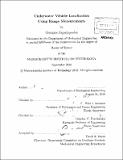Underwater vehicle localization using range measurements
Author(s)
Papadopoulos, Geōrgios
DownloadFull printable version (6.829Mb)
Other Contributors
Massachusetts Institute of Technology. Dept. of Mechanical Engineering.
Advisor
John J. Leonard.
Terms of use
Metadata
Show full item recordAbstract
This thesis investigates the problem of cooperative navigation of autonomous marine vehicles using range-only acoustic measurements. We consider the use of a single maneuvering autonomous surface vehicle (ASV) to aid the navigation of one or more submerged autonomous underwater vehicles (AUVs), using acoustic range measurements combined with position measurements for the ASV when data packets are transmitted. The AUV combines the data from the surface vehicle with its proprioceptive sensor measurements to compute its trajectory. We present an experimental demonstration of this approach, using an extended Kalman filter (EKF) for state estimation. We analyze the observability properties of the cooperative ASV/AUV localization problem and present experimental results comparing several different state estimators. Using the weak observability theorem for nonlinear systems, we demonstrate that this cooperative localization problem is best attacked using nonlinear least squares (NLS) optimization. We investigate the convergence of NLS applied to the cooperative ASV/AUV localization problem. Though we show that the localization problem is non-convex, we propose an algorithm that under certain assumptions (the accumulative dead reckoning variance is much bigger than the variance of the range measurements, and that range measurement errors are bounded) achieves convergence by choosing initial conditions that lie in convex areas. We present experimental results for this approach and compare it to alternative state estimators, demonstrating superior performance.
Description
Thesis (S.M.)--Massachusetts Institute of Technology, Dept. of Mechanical Engineering, 2010. Cataloged from PDF version of thesis. Includes bibliographical references (p. 79-83).
Date issued
2010Department
Massachusetts Institute of Technology. Department of Mechanical EngineeringPublisher
Massachusetts Institute of Technology
Keywords
Mechanical Engineering.